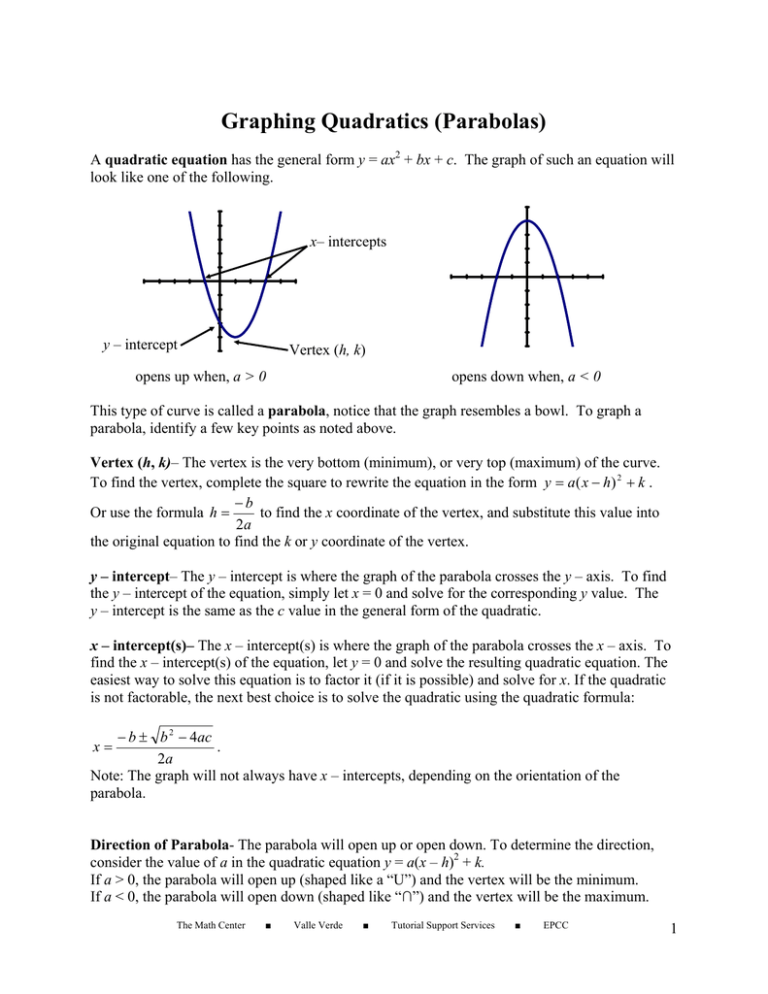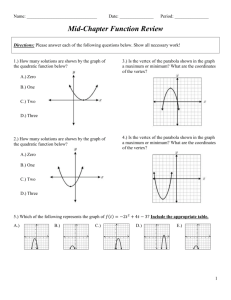Graphing Quadratics (Parabolas)
advertisement

Graphing Quadratics (Parabolas) A quadratic equation has the general form y = ax2 + bx + c. The graph of such an equation will look like one of the following. x– intercepts y – intercept Vertex (h, k) opens up when, a > 0 opens down when, a < 0 This type of curve is called a parabola, notice that the graph resembles a bowl. To graph a parabola, identify a few key points as noted above. Vertex (h, k)– The vertex is the very bottom (minimum), or very top (maximum) of the curve. To find the vertex, complete the square to rewrite the equation in the form y = a ( x − h) 2 + k . −b to find the x coordinate of the vertex, and substitute this value into Or use the formula h = 2a the original equation to find the k or y coordinate of the vertex. y – intercept– The y – intercept is where the graph of the parabola crosses the y – axis. To find the y – intercept of the equation, simply let x = 0 and solve for the corresponding y value. The y – intercept is the same as the c value in the general form of the quadratic. x – intercept(s)– The x – intercept(s) is where the graph of the parabola crosses the x – axis. To find the x – intercept(s) of the equation, let y = 0 and solve the resulting quadratic equation. The easiest way to solve this equation is to factor it (if it is possible) and solve for x. If the quadratic is not factorable, the next best choice is to solve the quadratic using the quadratic formula: − b ± b 2 − 4ac . 2a Note: The graph will not always have x – intercepts, depending on the orientation of the parabola. x= Direction of Parabola- The parabola will open up or open down. To determine the direction, consider the value of a in the quadratic equation y = a(x – h)2 + k. If a > 0, the parabola will open up (shaped like a “U”) and the vertex will be the minimum. If a < 0, the parabola will open down (shaped like “∩”) and the vertex will be the maximum. The Math Center ■ Valle Verde ■ Tutorial Support Services ■ EPCC 1 Example: Graph y = x 2 − 4 x − 5 Comparing this to the general form for a quadratic (y = ax2 + bx + c), a = 1, b = –4, c = –5. Begin by finding the vertex of the parabola (h, k). To find the h coordinate of the parabola, use the formula h = h= −b , 2a − (− 4) = 2. 2(1) Next find the k coordinate, by substituting h into the original quadratic. k = (2) 2 − 4(2) − 5 = −9 The vertex then is at (2, –9). Next find the y – intercept by setting x = 0. y = (0) 2 − 4(0) − 5 y = –5 The y – intercept then is at (0, –5). Notice that the y – intercept has the same value as c above. Finally, the vertex is a minimum (a is positive) and it lies below the x – axis, consequently, there must be two x - intercepts. Find these by setting y = 0 and solving the resulting quadratic equation. 0 = x 2 − 4x − 5 factoring this gives 0 = ( x + 1)( x − 5) applying the property of zero, yields the solutions (-1, 0) (5, 0) x = –1 ; x = 5. Resulting in x – intercepts of (–1, 0) and (5, 0). (0, -5) Plotting all of the points on a graph and connecting with a smooth curve gives the graph of the parabola shown at the right.. (2, -9) The Math Center ■ Valle Verde ■ Tutorial Support Services ■ EPCC 2





